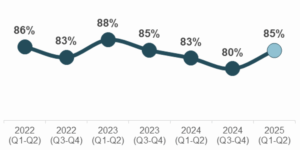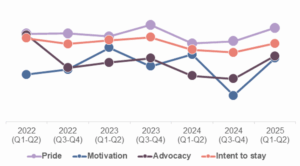Employee Engagement 2025 Mid-year Trends
It is half-way through the calendar year, which means it’s time to update you on the current trends and patterns, drawing on data from our benchmark database containing hundreds of organisations across diverse industries and company sizes. By aggregating engagement metrics across a broad spectrum of workplaces, this benchmark provides a reliable update on employee sentiment and organisational health in 2025 to date.
Our in-house research reflects shifts in key engagement areas – Pride, Motivation, Advocacy, and Intent to Stay – and offers a comparative view of trends over time. With engagement levels rebounding after a dip in late 2024, our analysis highlights encouraging improvements across all core areas and identifies where organisations are making the most impact in re-engaging their people.
What do we see?

Trend in engagement since the start of 2022

Trend in key areas within engagement since 2022
Encouragingly, our benchmark database reveals a strong upward trend in employee sentiment across 2025 to date, with the overall engagement score rising to 85.33% – up 4.72 points from 2024 (Q3-Q4). This welcomed improvement follows a noticeable dip in Q3-Q4 2024. The most significant gains were seen in Motivation, which jumped by 7.12 points to 82.13%, and Advocacy, which rose 5.72 points to 82.76%, indicating that employees are not only feeling more driven but are also increasingly likely to recommend their employer to others. Pride remains consistently high at 90.31%, while Intent to stay has also edged upwards to 86.13%, pointing to a stabilising workforce.
Looking at the biannual trends, Q3-Q4 2024 marked a low point, particularly in Motivation (72.98%), highlighting a period where employee morale may have been challenged. However, the sharp rebound in Q1-Q2 2025, with engagement back up to 85.33% and notable improvements across all drivers, suggests a widespread and effective organisational response. These shifts underscore the resilience of employees and the increasing focus organisations are placing on employee experience. While 2025 figures are approaching the engagement peaks of 2022 and 2023, the data also signals that there is still room to continue strengthening motivation and advocacy to match the consistently high levels of pride and retention.
Why the upward trend?
Post-Pandemic Workforce Investments
The upward trend in employee engagement across 2025 appears to be influenced by a number of post-pandemic workforce investments that organisations have made in recent years. These strategic shifts – born out of necessity during COVID-19 – are now delivering tangible cultural and performance benefits.
- Flexible working models: The widespread adoption of hybrid and remote working has given employees more control over how and where they work. This flexibility not only improves work-life balance but also fosters a greater sense of trust and autonomy, both of which are strongly linked to higher engagement and motivation.
- Renewed focus on wellbeing: Many organisations have embedded wellbeing more deeply into their people strategies, offering mental health resources, wellbeing allowances, and encouraging healthier work habits. This has helped to build more supportive environments where employees feel cared for and valued.
- Clearer career development pathways: In response to increased demand for growth opportunities, businesses have invested more in internal mobility, upskilling programmes, and structured career conversations. When employees see a future within their organisation, their intent to stay and motivation naturally rise.
- Cultural rebuilding: Post-pandemic, leaders have had to be more intentional in fostering connection, purpose, and shared values – particularly in hybrid environments. As a result, cultures have become more inclusive, communicative, and aligned with employee expectations.
Wider Economic and Social Factors
Beyond internal shifts, external economic and societal trends are also likely contributing to rising engagement levels.
- Economic stabilisation: With inflation beginning to settle and business confidence returning, many organisations have reinstated pay reviews, bonuses, and other financial incentives. This increased financial security can directly influence employee motivation and satisfaction.
- Better recognition and communication: Businesses have recognised the importance of regular, transparent communication – especially during uncertain times. Improved feedback loops and recognition schemes help employees feel more seen and appreciated, which boosts advocacy and pride.
- Stronger alignment with social values: There is a growing expectation for organisations to lead on issues like sustainability, diversity, equity, and social impact. Companies that actively demonstrate purpose and responsibility are finding it easier to engage employees who want to work for values-led employers.
- Impact of hiring windows on engagement: Hiring windows – periods in the year when organisations typically ramp up recruitment, often in Q1 and Q2 – can positively influence engagement by injecting fresh energy into teams, enabling internal movement, and relieving workload pressures. The rise in 2025 engagement scores, particularly in Motivation and Intent to Stay, aligns with these seasonal hiring patterns, suggesting that well-timed recruitment and onboarding may play a key role in boosting overall employee sentiment.
Taken together, these external factors not only support improved engagement – they actively reshape what employees expect from their workplace. Rather than being reactive, many organisations are now using external pressures as a springboard for positive, lasting cultural change.
How we can help!
The first half of 2025 has shown encouraging progress in employee engagement, with clear signs that both internal initiatives and broader external shifts are having a positive impact. From increased motivation and advocacy to the continued strength of pride and retention, it’s clear that organisations are investing more intentionally in their people -and seeing the rewards.
As we move into the second half of the year, the challenge will be to sustain this momentum. Engagement is not a one-time achievement, but an ongoing conversation. By continuing to listen closely, respond thoughtfully, and adapt to evolving employee expectations, organisations can turn this upward trend into long-term cultural strength.
If you’d like support understanding how your own engagement levels compare to these trends – or if you’re looking to uncover the specific drivers behind your workforce’s sentiment – our team is here to help. Get in touch to explore how our tailored engagement surveys and insights can empower your next steps – Contact us today!